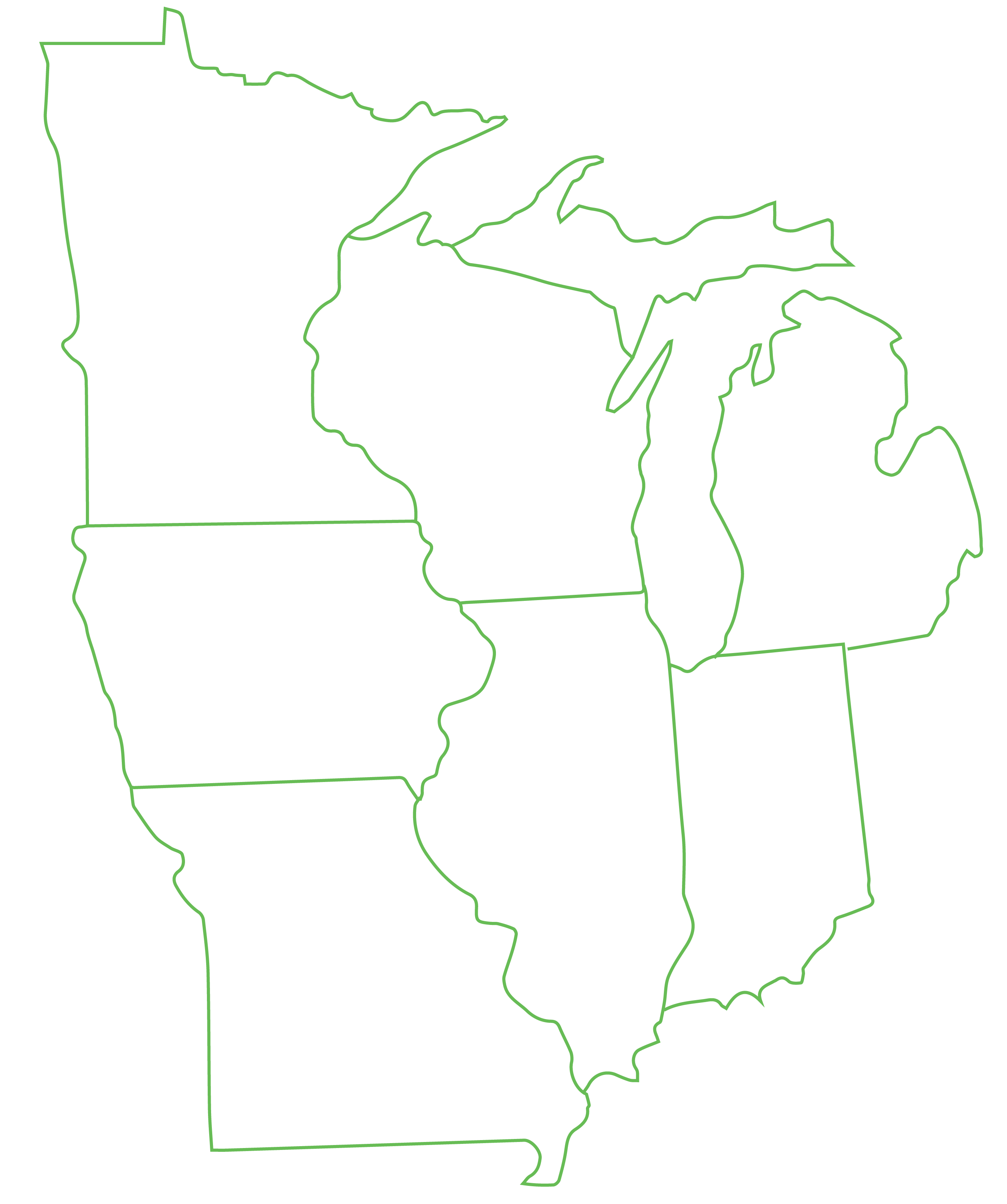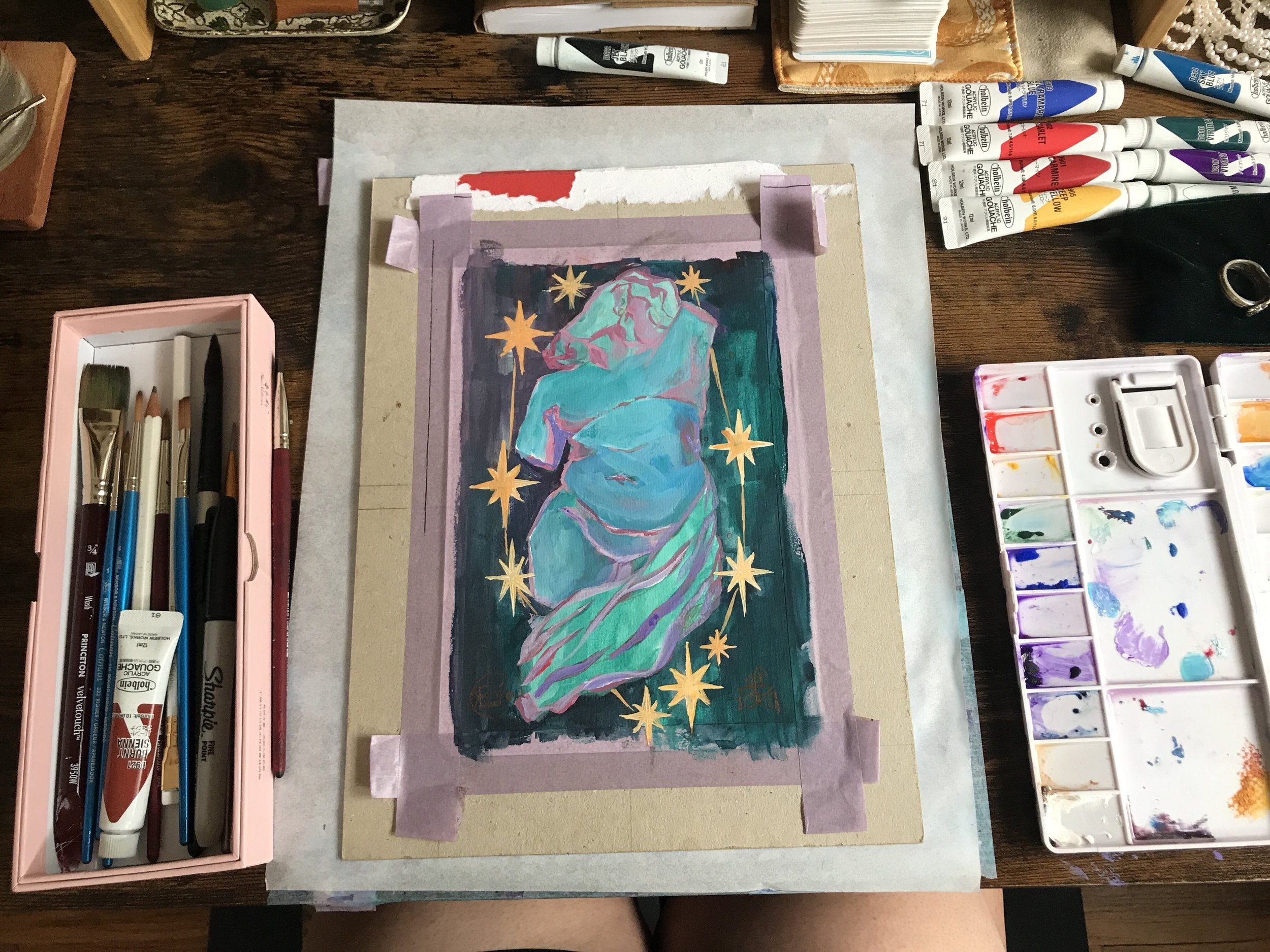routine
jameson malone
My words and the art I create are often separate. I have spoken about my art and process a handful of times, but it is rare that I show someone the art I create while discussing what I’m doing in it. I’m used to presenting my art behind a screen. My initial gallery was Instagram—no public speaking necessary.
I still consider myself an emerging artist. I am just a few years fresh into my career, and doing some of my first few solo shows in galleries. It’s a different kind of attention, and I’m not used to it yet, but it is encouraging me to be less coy when presenting pieces that have part of my heart left with them.
I am influenced by celestial bodies, music, mysticism, and the natural world. These were all prominent influences for me as a child too—I was deeply in love with space (still am), I always had headphones on (still do), I was intrigued by the paranormal (of course), and I was outside as much as possible (trying my best to now). A part of me feels lost while creating if I somehow neglect to include these four influences into my week.
Additionally, studying artists I admire has been key for my work. Typically it starts with a Google search, or discovering their work in an exhibit (for example: Winold Reiss’ “Short Haired Young Man in Collarless Shirt,” which I saw at Supernatural America: The Paranormal in American Art at the Minneapolis Institute of Art, 2022). That will often lead to me obtaining books on the artist (like a book on Pamela Colman Smith recently gifted to me by a dear friend). Studying them encompasses both learning about the artist’s history, so I can observe what influences the art, and studying what techniques they use, like brushstrokes, color palette, subject matter and symbolism, and so on.
Their techniques have altered the way I plan and apply new ideas to my art. The spiritual abstraction of Hilma af Klint (“Altarpieces, Group X, No.1,” 1915), the subconscious’ influence on creation according to Neo Rauch (“Kap,” 2018), and the symbolic representation within pieces of R.H. Ives Gammell (“A Pictorial Sequence,” 1941-1956) are all frequent sources for expanding my approach to artistic process and subject matter.
The cover of The Art of the Occult by S. Elizabeth, featuring a painting by Hilma af Klint. Jameson acquired this book while visiting the exhibition Supernatural America at the Minneapolis Institute of Art.
I would consider myself a new student of symbolism, and enjoy planning intricate pieces that represent big ideas, though I worry about leaning too far into obscurity. This worry was a caution instilled in me somewhere along the way. Will this art still be relevant to others if I dive fully into symbolism and surrealism? Regardless, I incorporate them into my work daily. Common symbols I include are halos, planetary symbols, and color correspondence (one way I like to use color correspondence is the respective color associated with each of the planets in our solar system).
Now, I would like to take you through my creative process during a standard afternoon, even though it has always been difficult to compile into words. Not only is it constantly changing, but I often wonder if describing my process sounds outlandish. I still wish to describe the process I experience so those reading know that the intimacy of creativity can be done in a vast amount of ways. The creative process is different for each individual.
Lately, creating a new piece has turned into a spiritual experience for me. I begin with lighting an incense, wafting it through the room, and sitting down with three deep breaths to settle into the studio space. (I'm currently using Mother Earth incense from GreenTreeCandle.)
My next step is picking an album to listen through. The sound needs to drown out things around me, otherwise I get distracted. (I’ll want to connect with the people around me, scroll my phone, reorganize—-do anything but the project at hand). When I’m fully immersed in an album, it’s as if I’m absorbing its creativity, allowing that to flow through me and my desired medium onto the canvas. This is what I mean in my bio when I say I am influenced by music.
These are usually albums I’ve listened through a lot of times, so I know their pacing like muscle memory. This helps kickstart my brain into a flow state, as if I was using a guided meditation. Experiencing the flow state of creation feels outside the bounds of time itself to me. How can that not feel spiritual? Once tuned into this state, it is easier to allow myself to let go of needing a controlled outcome to what I create. I allow myself to make intuitive decisions when something looks off, and this encourages a new path in the process to unfold.
Typically I work on multiple projects at once. I’m unsure if this was instilled in me specifically from hectic all-nighters in college, or if I’ve just done it my whole life but don’t remember. The technique seems to be a double-edged sword. While it is easier to come back to a piece with a fresh lens so I can incorporate new, passionate ideas, this only works for pieces with no impending deadline. If I take on multiple projects that all have due dates in the same month, I suddenly become overwhelmed and can only work on one thing at a time to get any of them done.
An overhead view of Jameson’s desk while they are in the middle of working on a piece titled “June 24th.” They are using Holbein Acryla Gouache.
Author’s note. August 9th, 2022. 10:11 AM. In retrospect, while working on multiple pieces at the same time for some upcoming shows, I would like to reanalyze how I experience the tides of creativity through the artist process. In my personal experience, at this current point in time, it is best to hone in on one goal. While doing this, prepare for the next endeavor by resting (leisure, stillness, play) in the places and spaces where you draw inspiration from most. I wish to include this note to say—you are allowed to change anything you want. Change your workflow, change your medium, change your subject matter. Adapt to inspiration.
From there, I ride it out. I remain mentally aware of when I reach a stalemate by asking myself questions:
“Why am I feeling frustrated?”
“Is this how I want this piece to appear?”
“Do I feel like this piece is finished where I’m at?”
“Is my body tired?”
When these questions come up, it’s time for a break. I cannot force myself to continue making marks knowing they are not beneficial to the piece I’m creating as a whole. This is always a nice time to eat a snack, hydrate, go on a short walk, run an errand, etc. etc. What I do for a break often changes depending on how I am in the moment, but lately my time away has been dedicated to playing with the cats, catching up on messages with friends, and eating strawberries!
After that, half an hour, a few days, or the next month goes by. I sit down, light an incense, waft it through the room, sit down with three deep breaths, and begin again.




